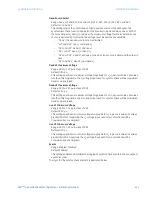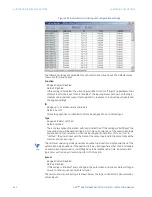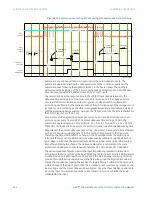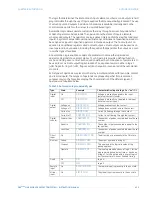
466
D90
PLUS
LINE DISTANCE PROTECTION SYSTEM – INSTRUCTION MANUAL
AUTOMATION INPUTS AND OUTPUTS
CHAPTER 8: AUTOMATION
Figure 392: Automation contact input debouncing mechanism and time-stamping
Automation equations and timers, are executed at the automation scan rate. The
automation operand reflecting the debounced state of the contact is updated at the
automation pass following the validation (mark 3 in the figure above). The update is
performed at the beginning of the 1 ms scanning pass so all automation functions and
equations are fed with the updated states of the contact inputs.
The automation operand response time to the contact input change is equal to the
debounce time setting plus a maximum of one protection pass. If the change of state
occurs just after a protection pass, the recognition is delayed until the subsequent
protection pass (that is, by the entire duration of the protection pass). If the change occurs
just prior to a protection pass, the state is recognized immediately. Statistically, a delay of
half the protection pass is expected. Owing to the 0.25 ms scan rate, the time resolution for
the contact input is less than 1 ms.
For example, sixteen protection passes per cycle on a 60 Hz system correspond to an
protection pass every 1.04 ms. With a contact debounce time setting of 3.0 ms, the
automation operand assertion time limits are: 3.0 + 0.0 = 3.0 ms and 3.0 + 1.04 = 4.04 ms.
These time limits depend on how soon the protection pass runs after the debouncing time.
Regardless of the contact debounce time setting, the contact input event is time-stamped
with a 1 ms accuracy using the time of the first scan corresponding to the new state.
Therefore, the time stamp reflects a change in the DC voltage across the digital input
terminals that was not accidental as it was subsequently validated using the debounce
timer. Keep in mind that the associated automation operand is asserted or de-asserted
later, after validating the change. The debounce algorithm is symmetrical: the same
procedure and debounce time are used to filter the OFF-ON and ON-OFF transitions.
The active impedance feature controls the input impedance presented to the system
according to the current state of the input. When the contact input circuitry initially detects
a voltage increase, it will draw 10 mA of current. If the state change is due to a transient
coupled through the stray capacitance of the field wiring, then the high current sink will
charge the capacitance causing the transient to rapidly decay. If voltage increase is due to
a state change of the field contact, then the increased current will have no impact on the
input voltage, and the state change will be validated. Once the input has been declared to
be on, the input circuitry will reduce the current drawn to 1 mA to minimize the power
dissipated by the input.
$&'5
9DOLGDWLRQWKUHVKROG
GHERXQFH
GHERXQFH
3URWHFWLRQ
SDVV
VFDQ
WLPH
7LPHVWDPS
DSSOLHG
7LPHVWDPS
DSSOLHG
2))
21
/2:
+,*+
,QSXW
YROWDJH
5DZ
FRQWDFW
VWDWH
)OH[/RJLF
RSHUDQG
$FWLYH
LPSHGDQFH
3URWHFWLRQ
SDVV
















































